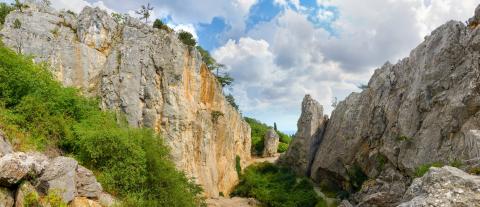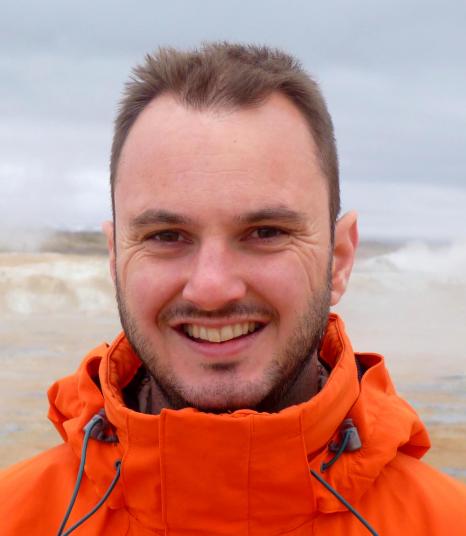
Benjamin Brigaud: geoscience for the energy transition
Benjamin Brigaud is a Professor of Earth Sciences at the Faculty of Sciences of Orsay, and a researcher at the Geosciences Paris-Saclay Laboratory (GEOPS - Univ. Paris-Saclay, CNRS) and Deputy Director of Education at the Graduate School Geosciences, Climate, Environment, Planets. A specialist in sedimentology, he works to reconstruct the history of basins, from paleoenvironments to diagenetic processes, i.e. those responsible for the consolidation of a sedimentary deposit.
"How is it that I can find marine fossils in a field behind my house?" This is perhaps one of the first surprising facts behind Benjamin Brigaud's vocation. Passionate about nature since he was a young boy, he became interested in the world and the landscapes that surrounded him at an early age. He was fascinated by natural systems such as mountains, volcanoes, minerals and fossils and the way they work. With his Bachelor's degree in hand, he began studying Earth Sciences at the University of Burgundy in 2001. This led to him specialising in sedimentology and writing a thesis on the understanding of the influence of the sedimentary context and the mode of rock formation on the petrophysical properties (i.e. physical and chemical properties and their interaction with fluids, such as porosity, water saturation and permeability) of the Dogger in the eastern Paris basin. This geological formation corresponds to very ancient deposits (Middle Jurassic) that are predominantly limestone.
"Behind this thesis, financed by the National Agency for Radioactive Waste Management (ANDRA), the challenge was to better understand the geological context of potential radioactive waste storage sites. Beyond the obvious academic interest of this subject, there was a societal interest with potential applications in mind. It was the coupling of these two dimensions - academic and applied - that motivated my choice of thesis topic and continues to guide my research today," says Benjamin Brigaud. Recruited in 2010 as a lecturer at the Faculty of Sciences of Orsay at Université Paris-Sud (now Université Paris-Saclay), Benjamin Brigaud joined the Geosciences Paris-Saclay Laboratory.
Dating diagenetic processes
In this laboratory, Benjamin Brigaud is interested in diagenesis, i.e. the physico-chemical processes likely to be involved in the transformation of sediments into sedimentary rocks. "My objective was not only to understand what happened when sediments were transformed into rocks, but also and above all to put an age on these diagenetic processes, to date them," says the lecturer.
He then embarked on innovative research projects in partnership with public bodies interested in possible applications. "I had the opportunity to conduct a study in partnership with the Bureau of Geological and Mining Research (BRGM) on the genesis of mineral resources, particularly fluorite, within sedimentary rocks. I also worked closely with Gaz de France - now ENGIE - on the origin and influence of chlorite coverings around grains of sand in the sandstone reservoirs of the Gironde estuary," adds Benjamin Brigaud. These projects led him to develop a new in situ method of radiometric dating of carbonates by uranium-lead (U-Pb), directly on thin slides, using laser ablation techniques coupled with mass spectrometry, to date diagenetic processes.
Diagenesis: a key to geothermal energy
As his research progressed and his dating method became more accurate, Benjamin Brigaud realised that a better understanding of diagenetic processes was a real key to geothermal energy, as they allowed him to evaluate the degree of porosity of a rock and therefore the probability that it contained water.
In the early 2010s, the lecturer therefore began to focus on this discipline with the aim of using his work to benefit the energy transition. "As geologists, we are used to working with the energy world, especially oil companies, but actually we do not often work to support the energy transition. But I was convinced that our method of dating diagenetic processes could be a very useful tool for predicting the location of hot water reserves underground," says Benjamin Brigaud.
Aware of the need to include algorithmic and modelling skills with his project, the lecturer began to approach mathematicians, notably from Université Paris-Saclay and CentraleSupélec. "The construction of Université Paris-Saclay really helped us to bring this together and become aware of the complementarity of our approaches," adds the lecturer.
UPGEO project: improving the efficiency of deep geothermal systems
It was as a result of this common interest that the Mathematics Laboratory of Orsay (LMO - Univ. Paris-Saclay, CNRS), the Mathematics Federation of CentraleSupélec, the Laboratory of Climate and Environmental Sciences (LSCE - Univ. Paris-Saclay, CEA, CNRS, UVSQ), the Camille Jordan Institute (ICJ - CNRS, École Centrale de Lyon, INSA Lyon, Univ. Claude Bernard, Univ. Jean Monnet), the Oceanic and Continental Environments and Paleoenvironments Laboratory (EPOC - CNRS, Polytechnic Institute of Bordeaux, Univ. de Bordeaux), BRGM, IFP New Energies (IFPEN) and the company GEOFLUID decided, under the leadership of the GEOPS laboratory and Benjamin Brigaud, to embark on the “Change of scale and simulation of heat flows to improve the efficiency of deep geothermal systems” project (UPGEO), financed by the French National Research Agency (NRA).
"In this project, which runs until 2024, our main objective is to successfully scale up the permeability measured in the laboratory to the sedimentary connectivity of reservoirs at the kilometre scale. This is a challenge that requires us to combine geological and mathematical data and concepts," explains Benjamin Brigaud.
Teaching the naturalist way
Like any passionate person, Benjamin Brigaud is driven by the desire to pass on his knowledge. "I love teaching in the field the naturalist way, teaching my students to observe the world around them." From undergraduate to graduate level, the lecturer teaches courses in sedimentology, stratigraphy and basin diagenesis. They range from petrography to logging and Benjamin Brigaud always has a strong attachment to field lessons.
The lecturer is in charge of a second-year Master's programme, the M2 Sedimentary Basins for the Energy Transition. "In Earth sciences, we often take our students into the field, always with a very mono-disciplinary approach, in segmented teaching units. Experience has shown that they can learn to compare different perspectives on the same site."
Based on this intuition, Benjamin Brigaud set up a multidisciplinary course in the Morvan region of France, bringing together specialists in the major themes of Earth sciences. The training is coupled with a project-based teaching unit. "I try to develop an innovative educational approach combining field learning and project-based teaching, so students learn about field and laboratory analysis and use virtual geology tools."
Training as close as possible to societal issues
After being Vice-President of Education in the Department of Earth Sciences, he is now Deputy Director of Education of the Graduate School of Geosciences, Climate, Environment, Planets of Université Paris-Saclay. He is also working on a training strategy in parallel to his other activities. "Thanks to the initial work carried out on research themes, we are currently working on synergies between research and teaching, with the main aim of offering our students pathways that are increasingly responsive to societal issues," concludes Benjamin Brigaud.

